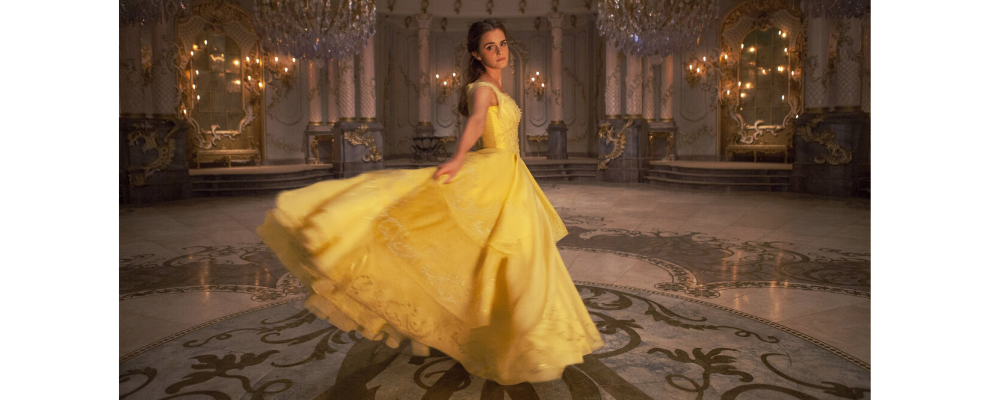Adapted to cinema for the first time in 1991 as a comic strip, Beauty and the Beast now, twenty-six years later, is re-adapted by Walt Disney to the cinema with live characters.
Adapted to cinema for the first time in 1991 as a comic strip, Beauty and the Beast now, twenty-six years later, is re-adapted by Walt Disney to the cinema with live characters. The story, written by Gabrielle-Suzanne Barbot de Villeneuve's in 1740 and published in La Jeune Américaine, et les Contes marins, earned her a reputation for being a subject for pedagogical lessons and became a classic. Having various versions, the general narrative of the story is based on an event that interrogates concepts and antagonisms such as beauty, ugliness, goodness, evil, pride, modesty, self-sacrifice, selfishness. Accordingly, a rich father living with three daughters and having lost all his possessions in one day; receives news that one of his ships has been saved and joyfully descends to the harbor. However, the scene he saw makes him to lose his last hope because the ship is unusable and the materials in it are looted. While returning home, the father was resting in chateau that he thinks it is an ownerless place, hoping to make at least one of his daughters happy by taking one of the roses in the garden to the home, though he could not afford clothes and jewelry requests of other girls. The girl who asked for a single red rose from her father was Belle, who is the main character of the story, as predicted.
When the father fulfills his daughter's wishes, the monster, which is the owner of the home at the same time, catches him and stipulates that he can be saved from death by leaving one of his daughters hostage in the chateau. Belle, the most beautiful of the three, makes the greatest sacrifice and goes along with her father to the chateau and has to live with the monster. This sacrifice she made to save his father's life and freedom seems in the beginning that she obliged herself to an undesired life. However, over time, Belle, who is accustomed to the life of the chateau, begins to love the host who looks rude, terrible and cruel but in fact he is not. When confronted with the possibility of losing him one day, she confesses her love and thus makes it possible for the beast, who is a gentle prince, to return to his real nature. She thus achieves the happiness she has been seeking, and her dreams have become real.
The story that Walt Disney produced in 1991, and in 2017, is a bit more complicated. There is a young girl who is different from her fellow in a way that villagers think she is “weird” and her father, who is an inventor living in a small town with her only daughter in the screen. The main character of the story is the young girl, who is also known by her beauty, Belle, (Emma Watson), but on the other hand she is also "strange". Belle's is distinct in her curiosity about books and learning, about the importance she gives intelligence, and about the life outside the town. On the other hand, as in the original story, she is so romantic enough to ask her father to bring a single red rose, and she is altruistic enough to prefer captivity in the chateau instead of his father. Moreover, she is about to experience a romantic love in her dreams inspired by the books she read. But still, the plot has been enriched in a way that will attract the audience; the elements necessary to make a cinematographic narrative from a classical children's tale have been used successfully.
Although the movie, which was targeting children in 1991, turned into a "fairytale for adults" in 2017, it can be said that there is not a big difference between the two versions in terms of fiction. Love, beauty, self-sacrifice and courage stand out as the elements underlined in both versions. These concepts are affirmed, discussed, and even described through Belle character. In this framework, the gender is discussed and a progressive-feminist approach, which is anachronistic in some ways, is adopted. The adventure, having an epic style from the beginning to the end, romanticizes Belle's story from a little town to the prince’s chateau. Moreover, it considers a beautiful and brave young girl’s will to find a true love as a romantic success despite the social norms.
The director (Bill Condon) says "Belle, the first modern Disney character and Disney princess, did not want to be a princess and was not looking for the prince. Belle is a princess who prefers finding herself, reading books, and traveling the world."[1] However, there is no point in the film that Belle does not dream of marriage or prefer reading a book to marriage. Belle's unwillingness to marry Gaston (Luke Evans) is something to do with his being an arrogant character, who emphasizes power and strength in his life. The reason why she loves the beast (Dan Stevens) is that she realizes that his being tyrant is only in the appearance, and there is no place for tyranny in his soul. The beast, to compare with Gaston, is not only more gentle and humble, but at the same time, open to change and development, which is what makes Belle's dream come true.
Besides, the romantic relationships that Belle read and admired in the novels are the stories that the beast also have them in his mind, but do not appreciate it or have no credibility until that day. After he encounters with Belle, his idea began to change. The fact that even a monster, who is aware of an intellectual like Shakespeare and has a magnificent library, can enter Belle's heart shows that the movie does not have a great feminist utopia. On the contrary, a subtle intelligence and culture, combined with a strong character (of course, together with prosperity), puts the unpleasantness of physical appearance to the back and this makes the beast mostly demanded prince of all time. Especially when the prince is full of love for Belle so that he can give up his life if Belle does not love himself…
On the other hand, she acts with her own truth instead of trying to meet the expectation of the society about the relations between women and men and makes conscious choices “to find herself/her personality.” Some of her behaviors such as her courage to save her father and the beast, her efforts to learn the truth about her mother’s death, her effort to teach reading to little girls in town, and her ability to do her father’s work prove this idea. In the movie, two female characters who appears in the supporting role besides Belle, Mrs. Potts (Emma Thompson) and Madame Garderobe (Audra McDonald) are a little combative characters. Messages on homosexuality in the movie, which led to discussions and even prohibitions, is a kindness that reflects the anxiety of box office that we have frequently encountered in the recent times.
Besides the length of the musical scenes and some breaks in the scenes aside, it can be said that Beauty and the Beast is a successful box office film. Even though the feature of addressing children is not completely lost, it is the kind that elders love to listen, and that difficult to believe. It can also be considered as a visual and musical version of an immersive fairy tale. The message, attached to the catastrophic image of a monster dancing in prince clothes and trying to use a cutlery, is that ugliness and rudeness of the character is in the shell rather than being the essence of a person (man?). Moreover, what is important is to explore the real nature of a person before thinking about the beauty and ugliness. In the movie; reading, dancing and traveling correspond to kindness and gentleness. The question of how reading Shakespeare makes a beast more gentle, humble, and self-sacrificing than a man who does not read Shakespeare, overshadows the glory of the tale. Furthermore, the question of where people, who have no opportunity to read Shakespeare because of their life standards and culture, stand in this story is hard to answer not only for children but even for adults.
Bibliography
Güzel ve Çirkin. Yön. Bill Condon. Orlando: Walt Disney, 2017.
[1] Poulou, Penelope “‘Güzel ve Çirkin’ Gişe Rekorları Kırıyor.” (31 Mart 2017). https://www.amerikaninsesi.com/a/3790716.html

